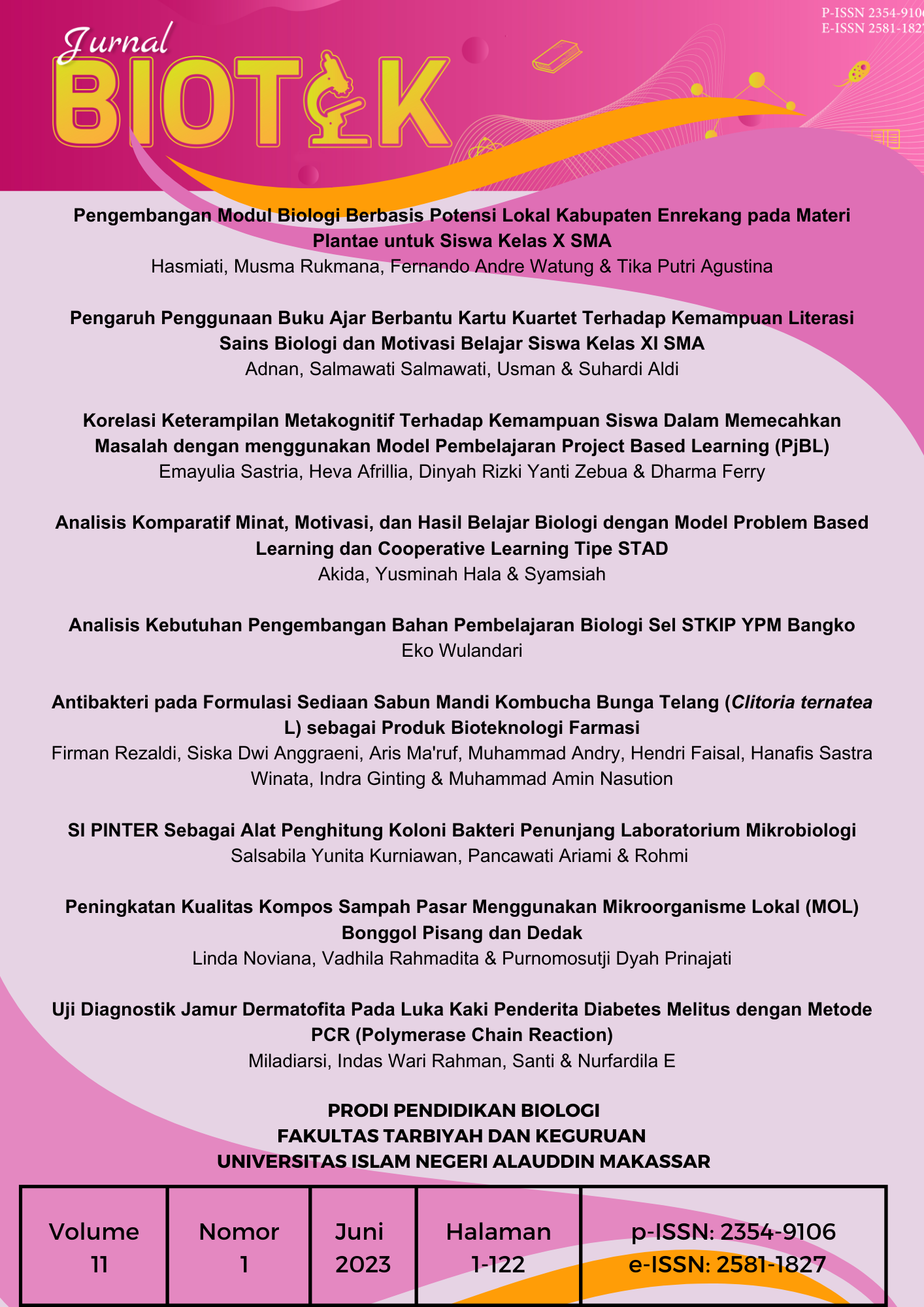SI PINTER Sebagai Alat Penghitung Koloni Bakteri Penunjang Laboratorium Mikrobiologi
Abstract
Colony counter tools are used to count bacterial colonies. The high price constraint makes manual calculation the preferred alternative. In this study, Innovations were made to the SI PINTER tool by replacing the power source with a battery and using digital prayer beads connected to a marker to display the results on the screen. The purpose of this study was to develop the SI PINTER tool as a microbiology laboratory support to improve the accuracy of bacterial colony counts. Standardization of the SI PINTER tool is done by comparing the results of calculations using a conventional Colony Counter and without using equipment (manual) to get accurate results of the number of bacterial colonies. This research method is quasi-experimental and the data was analyzed by One Way ANOVA test. The results of the One Way ANOVA statistical test showed a p-value = 0.996 > 0.05, indicating that there was no significant difference between the results of the number of bacterial colonies using conventional Colony Counter, SI PINTER and manual calculations. The SI PINTER tool can be used according to its function as a microbial colony counter and has portable capabilities because it only relies on electrical energy from batteries
Downloads
References
Arhandi, P. P., Firdausi, A. T., & Pradana, D. (2019). Aplikasi Penghitung Koloni Bakteri Berbasis Android. JIP (Jurnal Informatika Polinema), 6, 23–32. https://doi.org/https://doi.org/10.33795/jip.v6i1.288
Aulanni’am. (2012). Instruksi Kerja Pemakaian Colony Counter. Universitas Brawijaya: Malang.
Cappuccino, J. G., & Sherman, N. (1998). Microbiology: A Laboratory Manual (ed. 5). Benjamin/Cummings Science Publishing. https://faculty.washington.edu/korshin/Class-486/MicrobiolTechniques.pdf
Dagelman, J. (1967). Colony Counter. Massachussetts: Cambridge. https://patentimages.storage.googleapis.com/cd/9e/3f/6d2b0e45c87fb6/US3344259.pdf
Damayanti, N. W. E., Abadi, M. F., & Bintari, N. W. D. (2020). Perbedaan Jumlah Bakteriuri Pada Wanita Lanjut Usia Berdasarkan Kultur Mikrobiologi Menggunakan Teknik Cawan Tuang Dan Cawan Sebar. Meditory, 8(1), 1–4. https://doi.org/10.33992/m.v8i1.969
Dwidjoseputro, D. (2005). Dasar-dasar Mikrobiologi (ed. 16). Djambatan: Jakarta. ISBN: 979-428-605-2.
Fardiaz, S. (1993). Analisis Mikrobiologi Pangan (Ed. 1 Cet.). PT Raja Grafindo Persada: Jakarta. ISBN: 979-413-769-3.
Harley, J. P., & Prescott, L. M. (2002). Laboratory Exercises To Accompany Microbiology (ed. 5). McGraw-Hill Publishing. ISBN: 0-07-282905-2.
Hastuti, U. S. (2018). Petunjuk Praktikum Mikrobiologi (ed. 2). UMM Press: Malang. ISBN: 978-979-796-330-9.
Hazan, R., Que, Y. A., Maura, D., & Rahme, L. G. (2012). A Method for High Throughput Determination of Viable Bacteria Cell Counts in 96-Well Plates. BMC Microbiology, 12(259), 1–7. https://doi.org/10.1186/1471-2180-12-259
Imas, M., & Nauri, A. (2018). Metodologi Penelitian Kesehatan (1st ed.). Kemenkes RI: Jakarta.
Irianto, K. (2014). Bakteriologi, Mikologi dan Virologi (ed. 1). Alfabeta: Bandung. ISBN: 978-602-289-051-5.
Jongenburger, I., Reij, M. W., Boer, E. P. J., Gorris, L. G. M., & Zwietering, M. H. (2010). Factors Influencing The Accuracy Of The Plating Method Used To Enumerate Low Numbers Of Viable Microorganisms In Food. International Journal of Food Microbiology, 143, 32–40. https://doi.org/10.1016/j.ijfoodmicro.2010.07.025
Kadri, A. N., Gelgel, K. T. P., & Suarjana, I. G. K. (2015). Perbedaan Cara Penyebaran Suspensi terhadap Jumlah Bakteri pada Media Eosin Methylene Blue Agar. Indonesia Medicus Veterinus, 4(3), 205–212. https://ojs.unud.ac.id/index.php/imv/article/view/17499
Murtius, W. S. (2018). Praktek Dasar Mikrobiologi. Universitas Andalas: Padang.
Notoatmodjo, S. (2012). Metodologi Penelitian Kesehatan (ed. 2). Rineka Cipta: Jakarta. ISBN: 978-979-518-984-8.
Pardede, S. O., Tambunan, T., Alatas, H., Trihono, P. P., & Hidayati, E. L. (2011). Konsensus Infeksi Saluran Kemih Pada Anak. In Ikatan Dokter Anak Indonesia. Ikatan Dokter Anak Indonesia (IDAI): Jakarta. ISBN: 9789798421648.
Rosmania, R., & Yanti, F. (2020). Perhitungan jumlah bakteri di Laboratorium Mikrobiologi menggunakan pengembangan metode Spektrofotometri. Jurnal Penelitian Sains, 22(2), 76. https://doi.org/10.56064/jps.v22i2.564
Rostavia, I., Ariswati., H. H. G., & Nugraha, P. C. (2016). Colony Counter Multipen. http://digilib.poltekkesdepkes-sby.ac.id/public/POLTEKKESSBY-Studi-723-DraftSeminar.pdf
Seniati, Marbiah, & Nurhayati. (2017). Kajian Uji Konfrontasi Terhadap Bakteri Pathogen dengan Menggunakan Metode Sebar, Metode Tuang dan Metode Gores. Jurnal; Galung Tropika, 6(1), 42–48. https://doi.org/10.31850/jgt.v6i1.209
Siragusa, M., Dall’olio, S., Fredericia, P. M., Jensen, M., & Groesser, T. (2018). Cell Colony Counter Called CoCoNut. PLoS ONE, 13(11), 1–18. https://doi.org/10.1371/journal.pone.0205823
Volk, W. ., & Wheeler, M. . (1993). Mikrobiologi Dasar (5th ed.). Erlangga: Jakarta.
Wicaksono, E. B., Hardianto, & Muliawan, A. (2019). Rancang Bangun Penghitung Jumlah Koloni Bakteri Berbasis Arduino Uno. Teknika, 13(2), 123–128. https://jurnal.polsri.ac.id/index.php/teknika/article/download/1787/965
Wijaya, R. C., Utari, E. L., & Yudianingsih. (2015). Perancangan Alat Penghitung Bakteri. Jurnal Teknologi Informasi, 10(29), 1–8. https://doi.org/10.35842/jtir.v10i29.138
WIPO. (1998). Colony Counter. Intellectual Property Organization: America https://doi.org/10.1126/science.183.4130.1229-c
Yunita, M., Hendrawan, Y., & Yulianingsih, R. (2015). Analisis Kuantitatif Mikrobiologi Pada Makanan Penerbangan (Aerofood ACS) Garuda Indonesia Berdasarkan TPC (Total Plate Count) Dengan Metode Pour Plate. Jurnal Keteknikan Pertanian Tropis Dan Biosistem, 3(3), 237–248. https://jkptb.ub.ac.id/index.php/jkptb/article/view/289/251
Yusmaniar, Wardiyah, & Nida, K. (2017). Bahan Ajar Farmasi: Mikrobiologi Dan Parasitologi (ed. 1). Kementerian Kesehatan Republik Indonesia: Jakarta.
Copyright (c) 2023 Salsabila Yunita Kurniawan, Pancawati Ariami, Rohmi

This work is licensed under a Creative Commons Attribution-ShareAlike 4.0 International License.
Authors who publish with Jurnal Biotek agree to the following terms: Authors retain the copyright and grant Universitas Islam Negeri Alauddin Makassar right of first publication with the work simultaneously licensed under a Creative Commons Attribution License (CC BY-SA 4.0) that allows others to share (copy and redistribute the material in any medium or format) and adapt (remix, transform, and build upon the material) the work for any purpose, even commercially with an acknowledgement of the work's authorship and initial publication in Universitas Islam Negeri Alauddin Makassar. Authors are able to enter into separate, additional contractual arrangements for the non-exclusive distribution of the journal's published version of the work (e.g., post it to an institutional repository or publish it in a book), with an acknowledgement of its initial publication in Universitas Islam Negeri Alauddin Makassar. Authors are permitted and encouraged to post their work online (e.g., in institutional repositories or on their website) prior to and during the submission process, as it can lead to productive exchanges, as well as earlier and greater citation of published work (See The Effect of Open Access).

This work is licensed under a Creative Commons Attribution-ShareAlike 4.0 International License.



